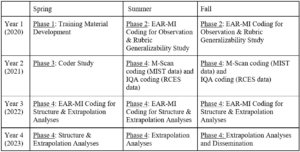Project Description
Purpose
The VEAR-MI project seeks to move the conversation beyond ambitious instruction and take initial steps towards specifying and measuring practices that are necessary to adequately respond to the growing needs of those who have not been well-served in mathematics classes. The main goals of VEAR-MI are to:
- validate a set of rubrics that attend to the existence and the quality of instructional practices that support equity and access in mathematics classes
- clarify the relationships between the practices outlined in the rubrics and aspects of teachers’ perspectives and knowledge as well as student outcomes
Through the systematic examination and evaluation of assumptions and inferences about the scoring, generalizations, and extrapolations that can be made for the EAR-MI rubrics, this project hopes to present a framework by which future analyses of observational protocols can be conducted and offer valuable insights into the procedures for making and testing validity arguments and determining the impact of the practices that such measures are intended to evaluate. Ultimately, the VEAR-MI project aims to yield foundational knowledge for improving mathematics teaching and learning, particularly for historically marginalized students, and address the critical need for research that directly links instructional practices that support marginalized students to student achievement and participation.
Methods
The VEAR-MI project aims to expand the validation process to ensure that we and other users of the EAR-MI rubrics can draw valid inferences from the resulting data. Specifically, our four-phased project uses Kane’s (2016) “argument-based approach to validity” to systematically build an argument for validity. We leverage data from two past research projects:
- the MIST Project (Middle-School Mathematics and the Institutional Setting of Teaching) at Vanderbilt University, and
- the RCES Project (Responsive Classroom Efficacy Study) at the University of Virginia.
We focus our attention on the scoring, generalization, and extrapolation inferences.
Timeline
We have designed this four-phase study to take place over four years:

Guiding Research Questions
Our overarching research question is: What are criteria regarding the use of the EAR-MI rubrics?
Answering this main question involves examining the following questions:
- What are productive training procedures?
- What important data collection protocols should be followed?
- Are there factors that influence scoring decisions?
- What are appropriate interpretations of scores generated by the EAR-MI?
- How do the EAR-MI rubrics perform in assessing teachers’ instructional practice in a wide range of classrooms?
- To what extent are issues of variance related to the teachers, observations, rubric items, or coders?
Anticipated Outcomes
There are several critically important outcomes anticipated from the VEAR-MI project:
- the development and documentation of an observational system for the EAR-MI rubrics
- insight into the extent to which there is a relationship between practices measured by the EAR-MI and other classroom instruction observation-based rubrics
- insight into the extent to which there is a relationship between practices measured by the EAR-MI and other outcomes for teachers and students